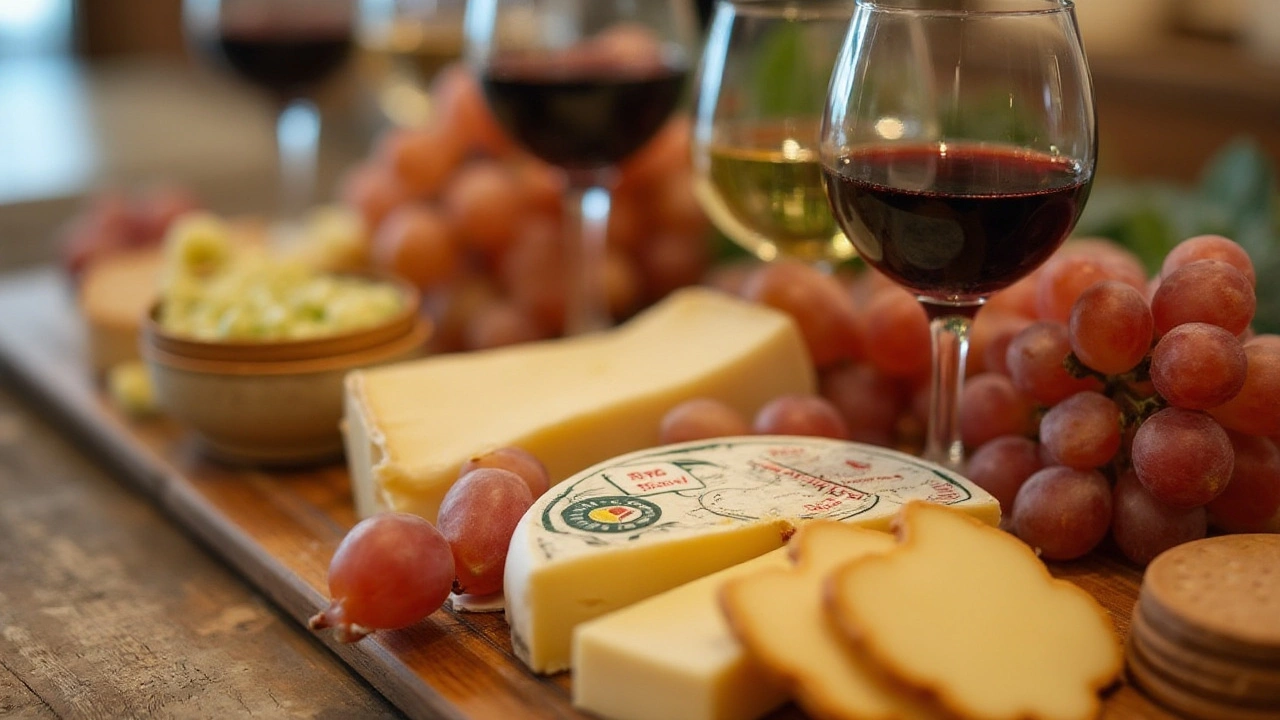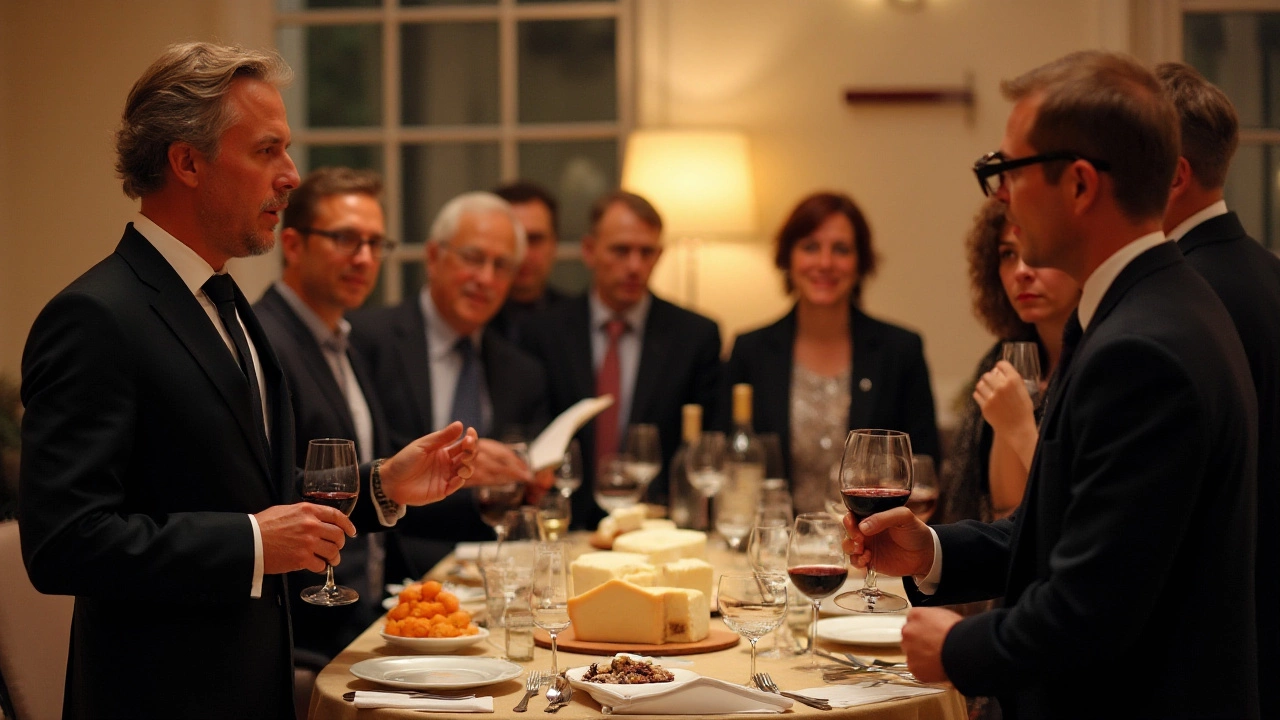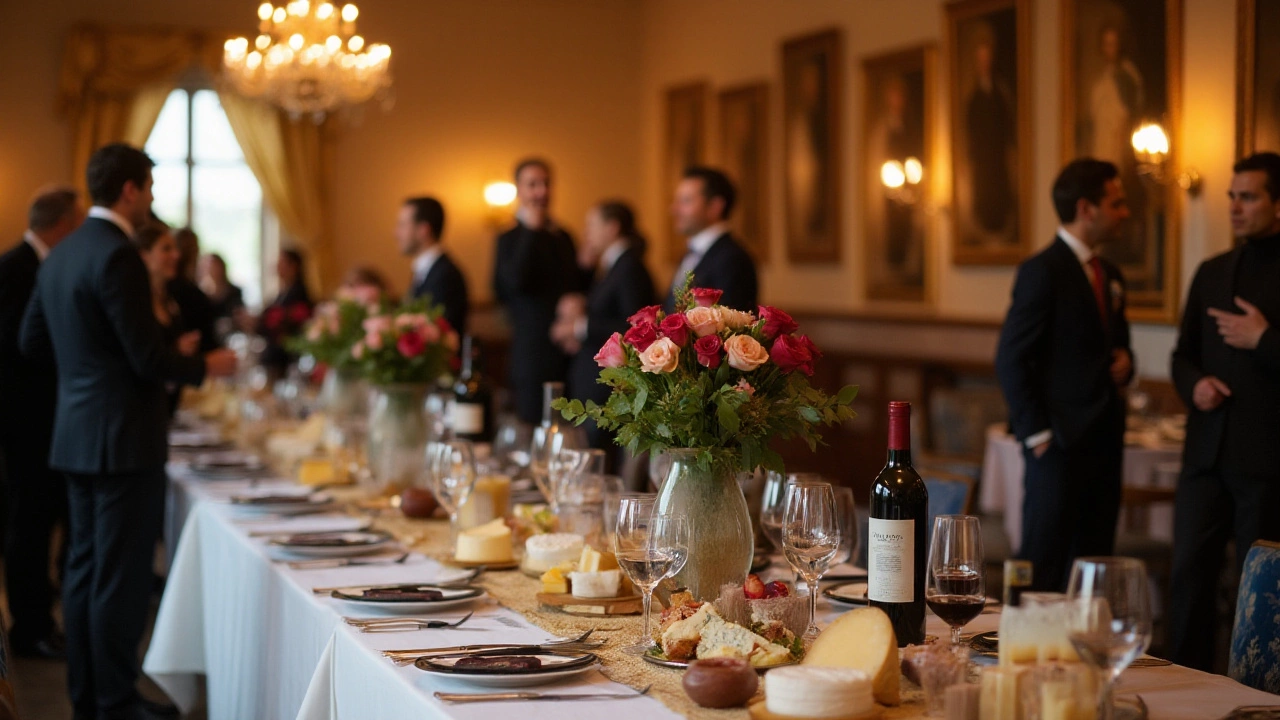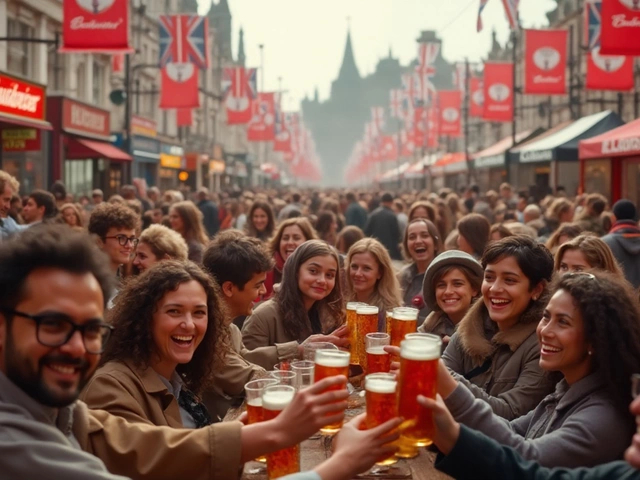Wine and cheese receptions have become a celebrated tradition across many cultures, known for their elegance and the sensory experiences they offer. These gatherings provide an excellent opportunity for guests to indulge in an array of flavors while enjoying each other's company in a relaxed setting.
Understanding the art of pairing wine with cheese involves more than placing them side by side; it's about creating a symphony of tastes that can elevate the flavors of both elements. Knowledge of various wines and cheeses helps in achieving this perfect balance.
For enthusiasts looking to host a wine and cheese reception, there is a myriad of factors to consider, from selecting appropriately matched pairs to setting the stage for an inviting experience. Thoughtful planning ensures that every aspect of the event contributes to a memorable occasion.
- Understanding Wine and Cheese Pairing
- Selecting the Right Combinations
- Planning the Reception
- Creating an Inviting Atmosphere
- Tips for Enhancing the Experience
Understanding Wine and Cheese Pairing
Pairing wine and cheese is an art that dates back centuries, a tradition steeped in sensory exploration and appreciation. It’s about the delicate balance between flavors, textures, and aromas, creating a memorable culinary experience. Experienced sommeliers and cheesemongers often say there are no absolute rules. Instead, it's about personal taste and the unique characteristics of the specific wines and cheeses in question.
Understanding the basics begins with wine and cheese pairing principles. The main goal is to create harmony where one does not overpower the other. For instance, the salty tang of a blue cheese can be beautifully mellowed by the sweetness of a port wine. Similarly, earthy cheeses like Brie tend to find their match in wines with a certain degree of acidity such as a Chardonnay or Sauvignon Blanc. The idea is to create complementary or contrasting flavors that work together to enhance the dining experience.
An essential aspect is understanding the elements of taste – salty, sweet, sour, bitter, and umami. Wines and cheeses carry these elements in various degrees, influencing how pairings work. Salty cheeses, for example, often pair well with sweet wines. The sweetness can cut through the saltiness, creating a balanced flavor profile. Aged cheeses, known for their robust and complex flavors, often demand a wine that can match or balance their intensity, such as a full-bodied red wine.
According to a study published by the Centre for Taste and Feeding Behaviour in France, taste perception can be significantly influenced by the sequence in which we consume cheese and wine. Their research suggests that the fat content in cheese coats the palate, altering the perception of acid and tannins in wine, making the latter appear smoother.
"Understanding how we taste is essential in pairing food and beverages," says Marie Curie-Marie, a renowned chef and food scientist.
When embarking on a new pairing venture, a practical approach is to begin with a few classic combinations. For instance, goat cheese paired with crisp Sauvignon Blanc is a time-honored match that demonstrates the magic of acidic wines cutting through creamy cheeses. Or consider a classic mature cheddar with Cabernet Sauvignon – where the rich cheddar complements the tannic structure of the wine.
In essence, successful pairings rely on a deep understanding of both the cheese and wine profiles, demanding a sensitivity to their individual traits. For those hosting a wine and cheese reception, it is important to experiment with different variations to discover what combinations resonate best with the audience. This experimental spirit is what elevates the event from a simple tasting to a full-fledged journey of flavors.
Selecting the Right Combinations
Choosing the perfect wine and cheese pairings is both an art and a science, requiring a keen understanding of flavor profiles and an adventurous spirit. With countless varieties of both wine and cheese available, the options for pairing are nearly limitless, but there are some tried-and-true pairings that have stood the test of time. The key lies in balancing the textures, intensities, and flavor characteristics so that neither the wine nor the cheese overwhelms the other. Understanding the regional origins can provide helpful guidance as wines and cheeses from the same area often complement each other through shared terroir and traditional taste profiles.
When selecting wine and cheese pairings, consider the fat content of the cheese, which can affect how the wine's acidity and tannins are perceived. Soft cheeses like Brie and Camembert pair beautifully with sparkling wines or light-bodied reds such as Pinot Noir. This combination allows the wine's crisp acidity to cut through the creamy texture of the cheese, creating a harmonious blend. Harder cheeses, like Cheddar or Parmigiano-Reggiano, call for wines with more structure and body, such as a robust Cabernet Sauvignon or Bordeaux blend. The firm texture and aging process of these cheeses match the wine's tannic backbone, enhancing both the depth of flavor and overall dining experience.
Sweet wines, such as Sauternes or late harvest Rieslings, are especially delightful when paired with blue cheeses like Roquefort or Stilton. The wine's sweetness counterbalances the strong, pungent flavors of the blue cheese, creating an interesting and pleasant contrast that can surprise even the most experienced palates. Using acidity as a guide, wines like Sauvignon Blanc and young Chardonnays pair well with fresh, tangy cheeses like goat cheese or feta. This combination takes advantage of the fresh, bright flavors found in both the wine and the cheese, allowing each element to shine.
"Great wine and cheese pairings are about finding harmony in flavor, allowing each component to bring out the best in the other. It's about balance and enjoyment," says Emma Johnson, a renowned sommelier specialize in wine and cheese pairing.
A more adventurous pairing might involve gewurztraminer with a washed rind cheese like Epoisses. The aromatic intensity of the wine is met equally by the robust, earthy character of the cheese, making it a match for those who appreciate bold flavors. Don't shy away from experimenting, as sometimes unconventional pairings can lead to delightful discoveries. Your taste preferences should guide you, so whether you prefer a classic pairing or something more eclectic, there's room to explore and enjoy.
A crucial aspect of reception ideas is diversity. Offering a variety of pairings that appeal to different palates can elevate the event, encouraging guests to engage with the experience and discover new preferences. Incorporate a mix of textures—from creamy to crumbly—and flavor profiles—from mild to intense—to keep the palate entertained. This variety ensures there is something for everyone, and provides a rich tasting experience.

Planning the Reception
When it comes to hosting a successful wine and cheese reception, meticulous planning is key to ensuring an unforgettable experience. The first step is to determine the size and scale of the event. Whether it's an intimate gathering for a few friends or a large event for business associates, the number of guests will guide many other decisions. Consider the venue that suits the occasion best: will it be a cozy home setting that encourages close conversations, or a more formal location that adds a touch of glamour? Choosing a venue with enough space for guests to comfortably mingle, yet intimate enough to foster interaction, is crucial.
Next comes the selection of wines and cheeses, which lies at the heart of the reception. Start by considering the season and local sourcing options, which can bring freshness and support to local artisans. A balanced selection should include a variety of reds, whites, and possibly sparkling wines, complemented by cheeses ranging from soft, creamy varieties to hard, aged options. The goal here is not just to cover the traditional pairings but also to allow experimentation; perhaps introducing guests to a bold blue cheese with a dessert wine could be a delightful surprise. Taking notes from past successful receptions can act as an invaluable guide in making these choices.
The presentation of these delicacies should not be overlooked. Investing in quality glassware and cheese boards can elevate the experience, while proper labeling of each wine and cheese offers guests insight into what they're savoring. Employing creative decor that reflects the theme of the reception can add an aesthetic appeal. A well-thought-out arrangement can also help in guiding guests through the tasting journey, beginning with lighter options and progressively moving to bolder flavors and heavier cheeses.
According to Hugh Johnson, a celebrated wine critic, "A wine is very much a product of all the factors in its growing environment. The same principle applies to cheese." His words remind us to consider the terroir of both elements when making our selections, allowing the pairing to tell a story of their origins and craftsmanship.
An often underestimated aspect of event planning involves the consideration of logistics, such as ensuring there is enough seating and that any dietary restrictions have been accounted for. Keeping extra quantities of preferred pairings on hand can prevent the possible disappointment of running out of a guest favorite. Engaging guides or sommeliers could lend an educational touch, guiding guests through the subtleties of tasting and pairing.
Additional features can also enhance the ambiance of a reception. Soft background music, perhaps a live performance by a local artist, can enrich the atmosphere without overpowering conversations. The lighting should be warm, contributing to a welcoming and relaxed mood. Thoughtful preparations like these can significantly enhance the guest experience, making an impression that lingers long after the last drop of wine has been poured.
Creating an Inviting Atmosphere
Crafting an inviting atmosphere for your wine and cheese pairing is as important as selecting the right flavors to serve. A successful reception is determined not only by the food and beverages but also by the ambiance that envelops the experience. To create a setting where guests feel at ease and engaged, thoughtful attention to the sensory environment is crucial. Lighting, decor, and music all play integral roles in shaping the event's mood. Soft, warm lighting can create a cozy and intimate setting, allowing the colors and textures of the wines and cheeses to stand out beautifully. Candles or fairy lights can add a touch of elegance and charm, casting gentle glows that enhance the sensory appeal.
Music is another powerful tool that can subtly influence the atmosphere of your reception. A carefully curated playlist should complement the elegant nature of the occasion without overwhelming the conversations. Gentle jazz or classical tunes are often preferred, offering a sophisticated backdrop that allows guests to appreciate the artful wine and cheese pairing. Additionally, the arrangement of tables and seating should encourage interaction. Small, tastefully arranged tables with floral centerpieces or wine-themed decor can foster mingling and conversations, making it easier for guests to discuss the variety of flavors they encounter.
Engaging the sense of smell is crucial during a wine and cheese reception. Choosing appropriate floral arrangements not just for their color but for their fragrance ensures the scents do not overpower the wine aromas.
"Wine and cheese have the power to connect people in unforgettable ways," said celebrated sommelier John Smith.This quote reflects the core intention behind hosting such an event. Employing breathable spaces where aromas can swirl harmoniously aids in enhancing the tasting experience.
Incorporating interactive elements can also elevate the reception. Consider setting up a tasting station where guests can experiment with various combinations of wine and cheese. Providing brief descriptions or cards with tasting notes enriches the experience, allowing attendees to develop a deeper appreciation for each pairing. Small chalkboards or elegant prints can introduce each cheese and wine, suggesting ideal matches and offering a touch of guidance to those less familiar with pairing principles.
If possible, having a knowledgeable wine expert on hand to guide the tasting can transform your event from simply enjoyable to truly enlightening. These experts can provide insights into flavor profiles and offer pairing suggestions that might surprise guests, adding an educational layer to the social engagement. Ultimately, the goal is to create an environment that appeals to all the senses, ensuring that every guest departs with a memorable experience, not just of the tastes they've savored but of the ambiance that facilitated their enjoyment.

Tips for Enhancing the Experience
At the heart of any memorable wine and cheese reception is the ambiance. Creating the right atmosphere profoundly shapes guests' perceptions and enjoyment. Ambient lighting, such as dimmed or soft fairy lights, can instantly add a layer of sophistication and warmth. Additionally, background music plays a pivotal role in setting the mood. Choosing a playlist that softly resonates with classical or jazz melodies helps create a serene space, inviting guests to immerse themselves in the sensory journey of flavors and aromas.
When laying out the reception space, consider the importance of flow and accessibility. Arrange tables and stations in a manner that encourages mingling rather than congestion. Each cheese and wine pairing should be clearly labeled with concise descriptions. Hiring knowledgeable staff to provide insights or conduct brief tastings at intervals can deepen the guests' understanding and elevate the experience. As Ernest Hemingway aptly put it,
"Wine is the most civilized thing in the world."Such reflections can often prompt engaging discussions among attendees, making the experience more meaningful.
Engagement doesn’t end with savoring fine wines and cheeses. Interactive elements like tasting notes booklets or digital apps that allow guests to rank and record their experiences can provide lasting memories. Guests appreciate learning, so consider including brief tasting workshops. This could involve them in making mock exams where they guess the origins or flavors of particular wines or cheeses. Offering an educational component enriches the experience and provides a takeaway beyond the physical senses.
Finally, consider the power of effective presentation. The artful arrangement of cheese boards is crucial. Choose rustic wooden boards or elegant marble slabs, and incorporate a range of textures and colors. Fresh fruits, nuts, and rustic bread can add visual appeal and offer palate cleansers, enhancing the tasting process. To top everything off, consider an unexpected element like a dessert wine or dark chocolate tasting to cap off the experience. These thoughtful details often leave an indelible impression.
Reception ideas like these contribute to the evening’s overall success, showing that the hosts have gone an extra mile to create an inclusive and memorable environment.


